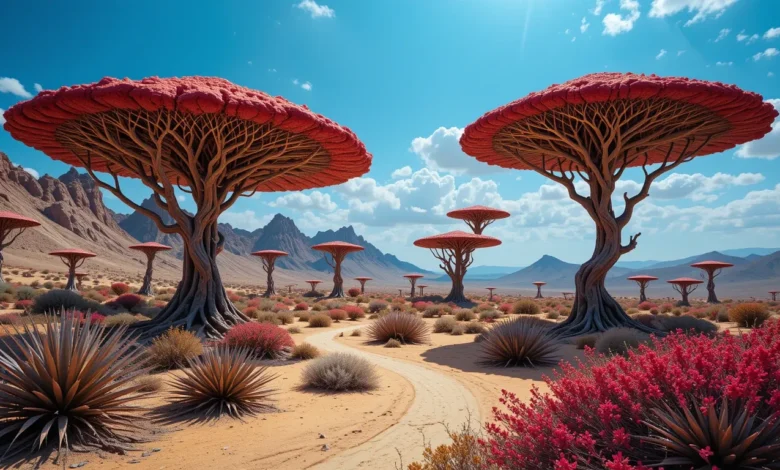🌴Socotra Island Travel Guide
Exploring Yemen’s Alien Landscapes & Dragon’s Blood Trees

🔮Introduction:
Socotra Island Travel Guide: First time I stood beneath a Dragon’s Blood Tree at dawn, its umbrella-like canopy silhouetted against a watermelon-colored sky, I understood why Socotra is called “Earth’s alien Eden.” As crimson sap – the legendary “dragon’s blood” – glistened on the bark, I felt like I’d stepped onto another planet.
This UNESCO World Heritage Site isn’t just a destination; it’s a biological time capsule where 37% of plant species grow nowhere else. After three expeditions to this Yemeni archipelago, I’ve crafted this guide to help you navigate its wonders responsibly.
⭐Why Socotra Island? The Last Eden on Earth
Socotra’s isolation birthed evolutionary marvels. For 20 million years, these islands drifted in the Indian Ocean, allowing species to evolve in surreal ways. I recall stumbling upon a Socotra Desert Rose – a bulbous, pink-flowered tree growing from barren rock – feeling like I’d discovered Dr. Seuss’s sketchbook come to life. Beyond the iconic dragon trees, you’ll find:
-
Endemic birds like the Socotra Sunbird flashing iridescent blue feathers
-
Marine ecosystems with 253 coral species and spinner dolphins
-
Limestone caves hiding ancient inscriptions at Hoq Cave
This isn’t just travel; it’s pilgrimage to nature’s laboratory.

“Dragon’s Blood Trees at sunrise in Socotra’s Firmihin Forest with misty mountains”
🛂 Planning Your Socotra Adventure
“Without our guide Ali, we’d have missed the hidden canyon behind Diksam Plateau,” I scribbled in my field notebook. Visiting requires navigating complex logistics:
✈️ Entry Protocol
-
Permits: Book through approved operators like Socotra EcoTours ($100-$200 permits)
-
Flights: Charter planes from Cairo (4hrs) or Abu Dhabi (2hrs) to Hadibu
-
Essentials Pack:
-
Water filter (streams are your lifeline)
-
USD cash (no ATMs)
-
Satellite phone (zero cell coverage)
-
Pro Tip: “November to March offers 25°C days and calm seas – ideal for snorkeling Dihamri’s coral gardens. Avoid June-September monsoon winds that ground flights.” – Ahmed Al-Socotri, Yemeni Tourism Board
🌵 Alien Landscapes & Bizarre Biodiversity
🐉 Dragon’s Blood Trees: Living Relics
At Firmihin Forest, I touched bark that’s bled crimson sap since the Bronze Age. Locals still use this “dragon’s blood” resin as medicine. These trees grow only 1cm yearly – the giants are over 600 years old.
Otherworldly Species
-
Desert Rose (Adenium obesum sokotranum): Pink-flowered “elephant leg” trees
-
Cucumber Trees (Dendrosicyos socotranus): Spiky-trunked succulents
-
Socotra Cormorant: Blue-eyed seabirds nesting on cliffs
⚠️ Solving Traveler Concerns
❓ “Is Socotra Safe?”
During my visits, safety meant:
-
Staying with registered guides who know tribal protocols
-
Avoiding unmarked trails (even short walks risk disorientation)
-
Monitoring weather alerts – flash floods surprise wadis
🌍 Protecting the Fragile Ecosystem
I joined beach cleanups after seeing plastic wash ashore. Key rules:
-
Camp only at designated sites like Arher Beach
-
Never remove plants/stones (endemics can’t survive elsewhere)
-
Use biodegradable soap (waterways feed unique species)
🗺️ My 5-Day Socotra Itinerary
Day 1: Marine Wonderland
Arrive in Hadibu → Snorkel Dihamri Marine Reserve among parrotfish and table corals → Camp under stars at Delisha Beach.
Day 2: Cave Secrets & Bioluminescence
Hike Hoq Cave’s 3km tunnels (stalactites, ancient scripts) → Evening paddle in Detwah Lagoon’s glowing waters.

“Stargazing at Delisha Beach with bioluminescent waves and Socotra tents”
Day 3: Forest of Giants
Sunrise at Firmihin’s dragon tree forest → Picnic at Dixam Plateau’s vertigo-inducing viewpoints.
Day 4: Dunes & Canyons
Sandboard down Hayf’s 100m dunes → Swim in freshwater Zerig Canyon oasis.
Day 5: Farewell in the Highlands
Homhil Sanctuary hike (frankincense trees, natural pools) → Fly out.
🧭 Final Thoughts: Becoming Socotra’s Custodian
Leaving Socotra feels like departing a dream. As my plane climbed over the Hajhir Mountains, I remembered Bedouin wisdom shared over campfire coffee: “We don’t inherit Socotra from ancestors; we borrow it from children.” By choosing ethical operators, packing light, and treading softly, you protect this evolutionary masterpiece. Fewer than 4,000 tourists visit yearly – be one who leaves it wilder than you found it.